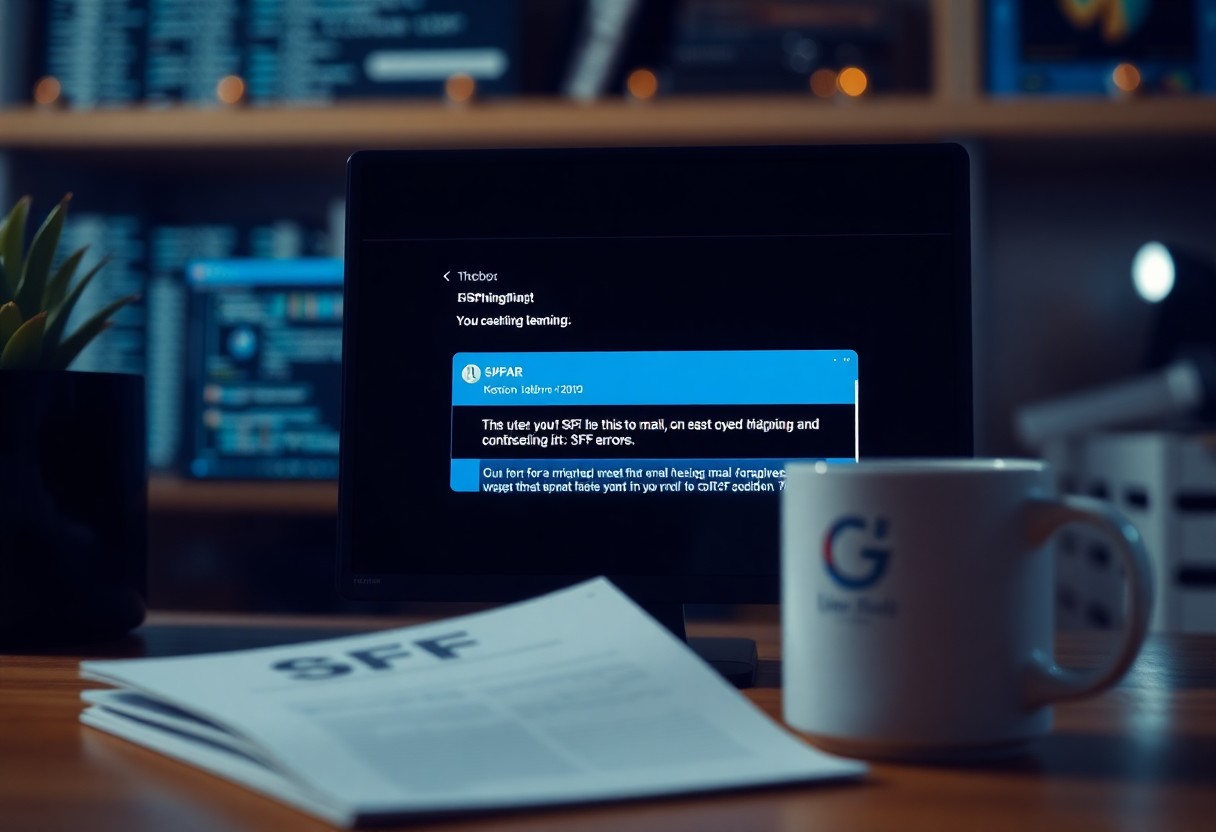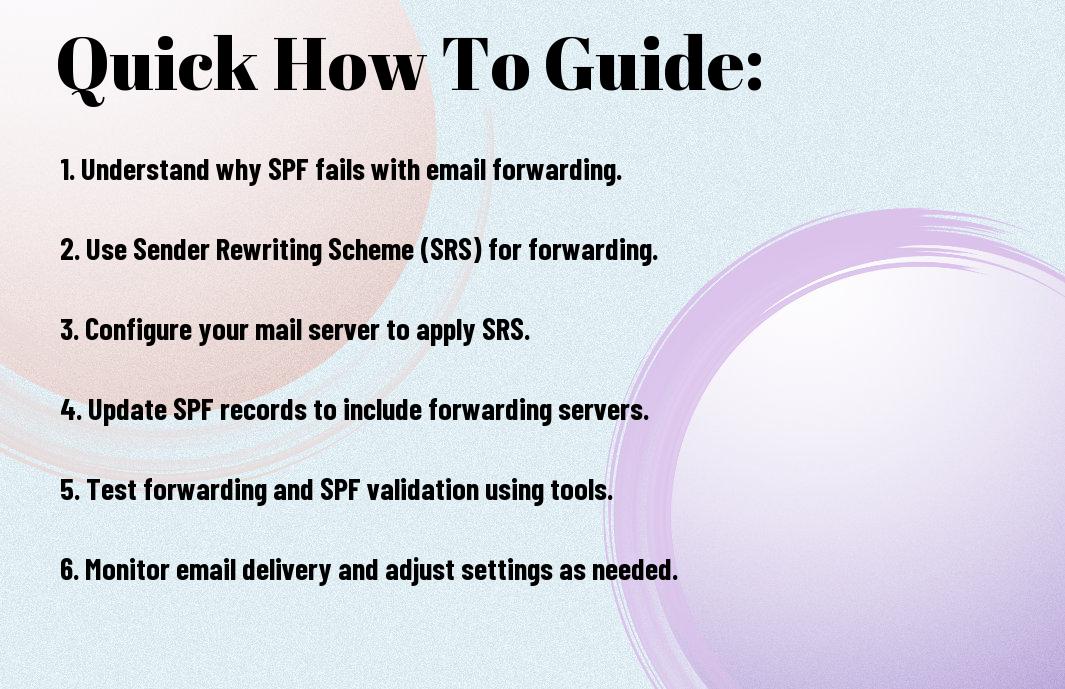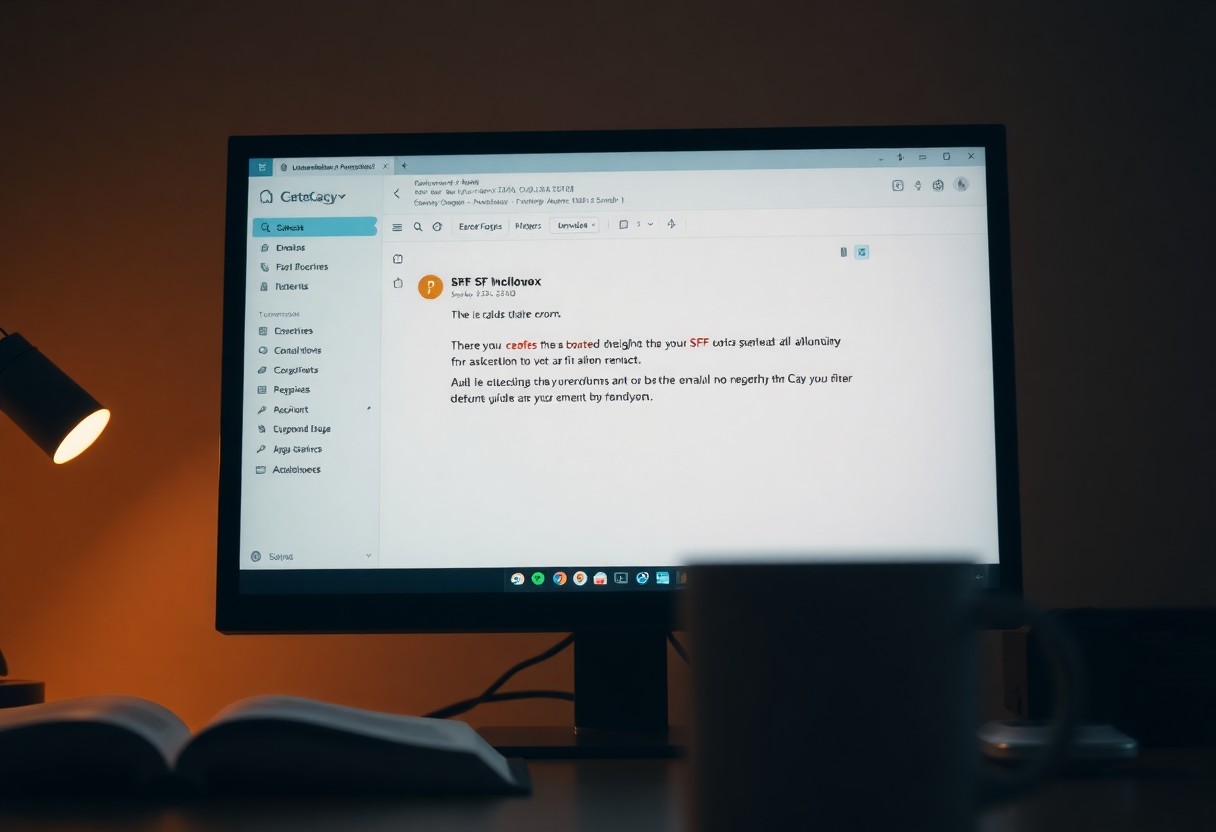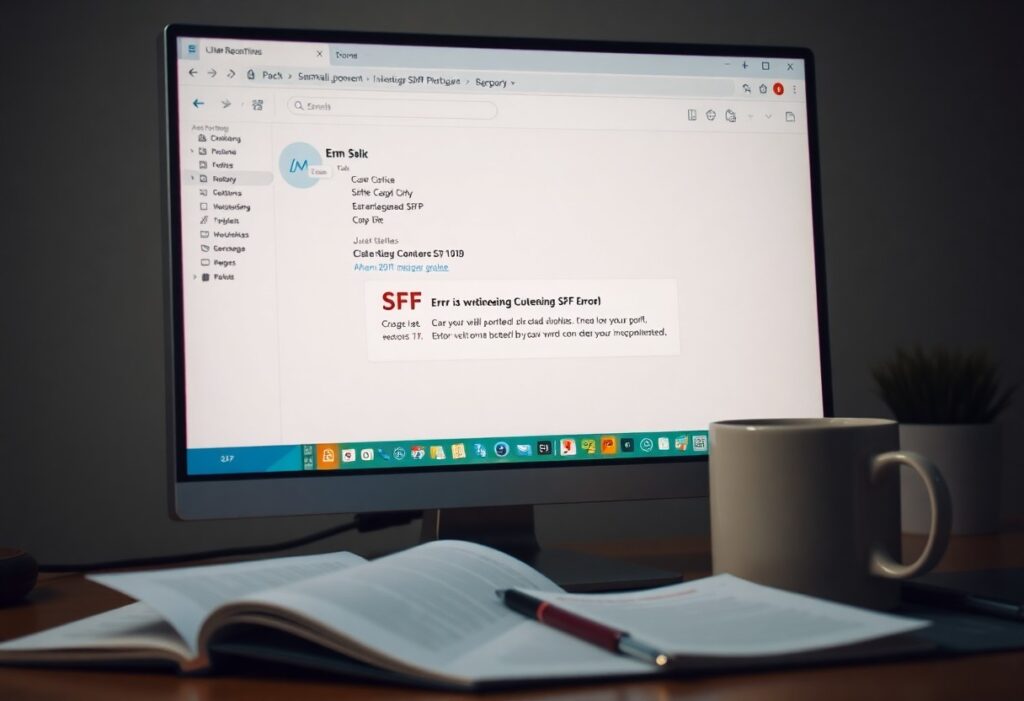Most email users are unaware that forwarding emails can disrupt your Sender Policy Framework (SPF) settings, leading to deliverability issues. If you rely on email forwarding for your communication, it’s important to understand why this happens and how you can effectively address it. In this guide, you’ll learn the steps you can take to maintain your SPF integrity while still utilizing email forwarding. Let’s investigate into the solutions that keep your emails flowing smoothly and ensure your messages reach their intended recipients without a hitch.
Key Takeaways:
- Email forwarding can cause SPF (Sender Policy Framework) failures, resulting in potential delivery issues for forwarded emails.
- SPF works by validating the sending server’s IP against the domain’s SPF record; forwarded emails may appear to come from an unauthorized server.
- To mitigate these issues, use SRS (Sender Rewriting Scheme) for email forwarding, which rewrites the sender address to maintain SPF compliance.
- Consider configuring DKIM (DomainKeys Identified Mail) and DMARC (Domain-based Message Authentication, Reporting & Conformance) alongside SPF for improved email authentication.
- Regularly review and update your SPF records to ensure that all authorized sending services are included, especially if forwarding is a common use case.

The Mechanics of SPF and Its Role in Email Authentication
SPF, or Sender Policy Framework, is an email validation system designed to prevent unauthorized senders from sending emails on behalf of your domain. By specifying which IP addresses are allowed to send emails for your domain in its DNS records, you enable receiving mail servers to verify the authenticity of incoming emails. This authentication process helps to protect your domain’s reputation and reduces the likelihood of your messages being marked as spam.
What Is SPF and Why It Matters
SPF is integral to email authentication because it helps prevent phishing and email spoofing. By validating that an incoming email has been sent from a legitimate source, you significantly lower the chances of your recipients falling victim to deceptive emails. Implementing SPF can also improve email deliverability, as email service providers often prioritize authenticated messages over those lacking verification.
How Email Forwarding Disrupts SPF Integrity
Email forwarding can hinder SPF records by allowing unauthorized servers to send emails on behalf of your domain. Since SPF checks the sending IP address against those specified in your domain’s record, forwarded messages often fail this test, resulting in poor deliverability or even blocking by the receiving server.
When an email is forwarded, the original sender’s information may be obscured, leading to a scenario where the forwarding server’s IP does not match your SPF record. This mismatch can trigger SPF failures, causing legitimate messages to be lost or marked as spam. As a result, both the sender’s and receiver’s trust can be compromised. Many email providers apply strict SPF validation rules, which can further aggravate issues, especially in high-volume email campaigns or crucial communications. Understanding this dynamic is crucial for maintaining effective email communication while utilizing forwarding services.


Common Missteps When Forwarding Emails
Many users unknowingly make errors that contribute to SPF failures when forwarding emails. These missteps can lead to deliverability issues and increased chances of your emails landing in the spam folder. One of the frequent mistakes is failing to adjust settings according to your domain’s specific needs, which can compromise the integrity of your email authentication process.
Ignoring Domain Settings
Overlooking your domain’s specific settings when forwarding emails can be detrimental. For instance, if you don’t configure your SPF record to include forwarding services, the forwarded emails could fail SPF checks and lead to rejection by recipients’ servers. Always ensure that the forwarding path aligns with your domain’s authentication protocols.
Misconfiguring DNS Records
Misconfigurations in DNS records are a common error that can hinder email forwarding effectiveness. If you mistakenly set a wildcard character in your SPF record or neglect to include necessary IP addresses, emails may be marked as unauthorized. This often results in frustration when legitimate messages get filtered out or blocked altogether.
A specific example of misconfigured DNS records includes failing to update your SPF record after changing your email service provider. In one case, an organization switched to a new hosting provider but didn’t adjust their SPF settings accordingly, causing nearly half of their emails to be rejected within days. Ensuring your DNS records are precise and current is vital to maintain deliverability and protect your email’s reputation. Regular audits of your DNS settings can help catch these issues before they escalate into bigger problems.
Strategies to Preserve SPF When Forwarding
To ensure that email forwarding doesn’t disrupt SPF validation, consider implementing specific strategies that maintain the integrity of your SPF records. One effective approach is to utilize Sender Rewriting Scheme (SRS) to rewrite the sender’s address during forwarding. Additionally, you could focus on whitelisting trusted forwarding services as a proactive measure, helping to ensure that forwarded messages are delivered without SPF errors.
Implementing SRS (Sender Rewriting Scheme)
SRS rewrites the sender’s address in forwarded emails to match the forwarding server’s domain. By doing this, the SPF check validates successfully since the forwarded message now appears to come from an authorized source rather than the original sender. Setting up SRS requires configuring your mail server or using third-party SRS tools, ensuring smooth email delivery without triggering SPF failures.
Whitelisting Forwarding Services
Whitelisting reliable forwarding services can significantly reduce SPF-related issues. By adding these services to your SPF record, you authorize them to send emails on your behalf. This helps mitigate the risk of rejected messages and improves overall email deliverability.
Selecting the right forwarding services for whitelisting involves researching their SPF policy and verifying their reliability. Popular services like G Suite and Microsoft Exchange typically have dedicated configurations that work seamlessly with SPF. For instance, if you use a forwarding service that doesn’t modify the sender address, make sure their servers are included in your SPF record, allowing messages to pass the SPF check without complications. Regularly reviewing and updating your SPF record to include any new services you adopt ensures ongoing deliverability and security across your email communications.
Advanced Techniques for Email Forwarding
Email forwarding can be tricky, especially when balancing security and deliverability. You can employ several advanced techniques to optimize your SPF settings while ensuring your forwarded emails reach their recipients without issues. Here’s a breakdown of helpful strategies:
- Utilizing custom scripts for SPF management
- Combining DKIM and DMARC for enhanced security
- Implementing third-party forwarding services
- Regular audits of your SPF records
Table of Advanced Techniques
| Technique | Description |
|---|---|
| Custom Scripts | Use scripts that automatically update SPF based on your current sending practices. |
| DKIM & DMARC | Implement these protocols alongside SPF to further protect your domain. |
| Third-party Services | Utilize dedicated services that streamline the forwarding process while respecting SPF. |
| Regular Audits | Continually check your SPF records for accuracy and effectiveness. |
Utilizing Custom Scripts for SPF Management
Implementing custom scripts can significantly enhance your SPF management by automating the updates based on your sending patterns. These scripts can pull data from your mail servers and adapt your SPF records in real time, ensuring that only authorized servers can send emails on behalf of your domain. This approach minimizes the likelihood of errors and helps maintain your email’s integrity.
Combining DKIM and DMARC for Enhanced Security
Integrating DKIM and DMARC with your SPF records creates a more robust email security framework. DKIM provides a digital signature that verifies the sender’s domain, while DMARC helps establish policies for handling emails that fail SPF or DKIM checks. This combination not only strengthens your domain’s reputation but also reduces the risk of phishing attacks targeting your users.
Expanding on the combination of DKIM and DMARC, implementing these protocols allows you to specify how receiving servers should handle authentication failures. For instance, with DMARC, you can request that non-compliant emails be quarantined or rejected outright, enhancing your defense against spoofing. Furthermore, this creates visibility into your email traffic, allowing you to monitor who is sending emails on behalf of your domain and identify potential security risks faster.
The Future of Email Forwarding and SPF Adaptation
The landscape of email forwarding is evolving rapidly as organizations and individuals seek solutions to enhance communication without sacrificing security. As new technologies emerge, the adaptation of SPF alongside these changes will become increasingly vital. Staying updated on these developments and applying best practices will ensure your emails maintain high deliverability rates while protecting your domain’s reputation.
Trends in Email Authentication Techniques
Email authentication techniques continue to shift toward more resilient frameworks, with DMARC and BIMI gaining traction. As SPF evolves, you’ll see a greater integration of these techniques, further bolstering security and combatting spoofing efforts. This multi-layer approach creates a stronger defense against phishing attacks and ensures that your communications are trustworthy.
The Role of ISPs and Email Providers
ISPs and email providers play a significant role in the future of email forwarding and SPF adaptation. They have the power to implement more sophisticated systems that seamlessly preserve SPF compliance during email forwarding. Collaboration among providers can lead to adopting universal standards, making it easier for users to send and receive forwarded emails without losing deliverability.
With providers like Google and Microsoft leading the charge, there is significant pressure for ISPs to embrace enhanced email forwarding protocols. These providers are already experimenting with new algorithms and shared policies that prioritize SPF, DKIM, and DMARC alignment. If ISPs can agree on a standardized approach, it could simplify the configuration for users and minimize complications arising from forwarded emails. Consequently, an industry-wide transition could reshape how email forwarding operates, benefitting both senders and recipients alike by ensuring seamless communication with built-in security measures.
Conclusion
Taking this into account, it’s important for you to understand that email forwarding can disrupt SPF configurations, affecting the deliverability of your emails. By implementing strategies such as using SRS (Sender Rewriting Scheme) or adjusting your SPF records to include the forwarding service, you can effectively resolve these issues. Staying proactive about your email settings will help ensure your messages reach their intended recipients without complications.
FAQ
Q: What is SPF and why is it important for email delivery?
A: SPF stands for Sender Policy Framework. It is an email authentication method that helps prevent unauthorized users from sending emails on behalf of a domain. By specifying which mail servers are permitted to send email for your domain, SPF helps improve email deliverability and protects against spoofing and phishing attacks. When email forwarding is used, SPF checks can fail, leading to legitimate emails being marked as spam or rejected by the receiving server.
Q: How does email forwarding interfere with SPF?
A: Email forwarding often sends an email from a different server than the original sender. This can cause SPF checks to fail because the receiving mail server verifies the sending server against the SPF record of the original domain. If the forwarding server is not included in the SPF record, the receiving server may treat the email as unauthorized, leading to delivery issues.
Q: What are some methods to fix SPF issues caused by email forwarding?
A: One effective method to address SPF issues is by implementing a “Sender Rewriting Scheme” (SRS). This technique modifies the envelope sender of the forwarded email to make it appear as though it is coming directly from the forwarding domain. Additionally, ensuring that the forwarding service you use is designed to handle SPF records properly can help mitigate issues. You can also consider adding the forwarding server to your SPF record, if applicable.
Q: Can I use DMARC along with SPF to enhance email deliverability?
A: Yes, DMARC (Domain-based Message Authentication, Reporting & Conformance) can be used in conjunction with SPF. DMARC allows domain owners to set policies on how emails that fail SPF and DKIM checks should be handled. Implementing DMARC policies can enhance email security and improve the chances of legitimate emails being delivered, even when forwarded. It’s necessary to configure DMARC with consideration of the forwarding practices used by your recipients.
Q: Are there any specific email providers that simplify handling of SPF with forwarding?
A: Many modern email providers offer features specifically designed to address issues with email forwarding and SPF, such as Google Workspace and Microsoft 365. These platforms often automatically handle SPF configuration for forwarded emails or provide detailed guides on how to adjust SPF records appropriately. It’s beneficial to check the documentation from your email service provider to find targeted solutions for managing SPF with email forwarding.

